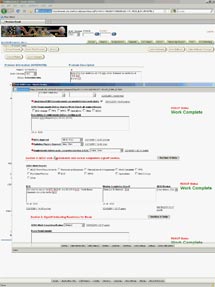
Handy Links
SLAC News Center
SLAC Today
- Subscribe
- Archives: Feb 2006-May 20, 2011
- Archives: May 23, 2011 and later
- Submit Feedback or Story Ideas
- About SLAC Today
SLAC News
Lab News
- Interactions
- Lightsources.org
- ILC NewsLine
- Int'l Science Grid This Week
- Fermilab Today
- Berkeley Lab News
- @brookhaven TODAY
- DOE Pulse
- CERN Courier
- DESY inForm
- US / LHC
SLAC Links
- Emergency
- Safety
- Policy Repository
- Site Entry Form

- Site Maps
- M & O Review
- Computing Status & Calendar
- SLAC Colloquium
- SLACspeak
- SLACspace
- SLAC Logo
- Café Menu
- Flea Market
- Web E-mail
- Marguerite Shuttle
- Discount Commuter Passes
-
Award Reporting Form
- SPIRES
- SciDoc
- Activity Groups
- Library
Stanford
Around the Bay
Radiological Work Control Process Goes Online
Radiological work planning at SLAC took a quantum leap in efficiency in January thanks to a new automated system for approving work associated with equipment required for the radiological safety of accelerators. The new online system is the result of a year-long effort that included the Office of the Chief Information Officer Application Development group, the Accelerator Operations & Safety Division Maintenance Office, and Accelerator Directorate safety officers. Now, when shielding blocks need to be moved or when radiation protection safety hardware needs repair, technicians and safety officers can track and manage the projects with a click of the mouse.
"The new electronic Radiation Safety Work Control Form is a big step in the right direction," said Accelerator Directorate Safety Officer Zoe Van Hoover, one of the principal customers helping to get the new system up and running. "It allows everyone involved in the Work Planning and Control of work on radiation safety systems to monitor status and provide their work approval from any computer."
The previous system required a time-consuming trip down to the Main Control Center—where tracking and managing radiological safety projects involved three-ring binders filled with paper forms. But even though an online tracking system may seem like a logical step for managing projects of this sort, the degree of complexity behind approval chains and on-the-ground workflow proved challenging to automate. Now, after many rounds of rigorous testing and consultation with end users, the new system is online and working smoothly.
The Accelerator Directorate, which is managing accelerator operations at the Linac Coherent Light Source and looking toward the startup of FACET in summer 2011, is currently using the new system. Over the next several run cycles, operators and safety officers hope to tailor it for similar work planning associated with the SPEAR accelerator at the Stanford Synchrotron Radiation Lightsource.
—Brad Plummer
SLAC Today, February 17, 2011
